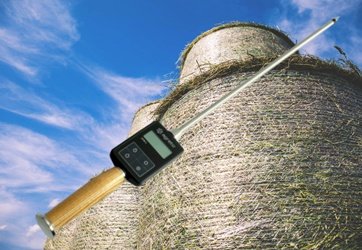How To Use A Hay Moisture Tester

The consequences of harvesting, baling and storing hay with incorrect moisture levels are many and costly! Monitoring the moisture content of hay with a hay moisture tester is a quick and easy way to help prevent crop, revenue, and property loss.
There are different methods for measuring moisture with a hay moisture tester, so your Instrument Choice Scientists decided to check out the best methods. Here’s what they found.
Read on for the best ways to manage forage moisture content to create a safe, stable, and valuable product.
Why Use a Hay Moisture Tester?
Hay moisture has a direct and profound impact on hay quality. Where crop moisture is too high, the product will be less palatable, develop mould (and potentially mycotoxins), and in extreme cases, cause thermal expansion, which can lead to combustion. If the moisture content is too low, nutritional values reduce, hay volume reduces, and the final product becomes less palatable.
Hay Moisture Level Insights
1. Monitor hay moisture within a targeted range
Hay is heterogeneous in nature, so it’s a good idea to evaluate moisture levels within a range rather than aiming for a specific value.
2. ‘Ideal’ moisture levels
As a rule of thumb, hay baled at more than 20% moisture is at risk of overheating or going mouldy - which means poor nutritional quality feed. What’s worse, at 25 to 35% moisture (75 to 65% dry matter), spontaneous combustion (and so catastrophic crop loss) is likely to occur. At less than 18%, moisture nutrition, bale volume and palatability deteriorate.
|
Scientist’s Hay Moisture Guidelines Without preservatives: the recommended moisture content range for baling hay is 18-20%. With preservatives: Check the moisture content guidelines outlined by the manufacturer of your chosen preservative. NOTE: The best moisture content for your crop and circumstances can vary significantly (see below). |
3. Determining your ‘ideal’ moisture levels
Producing consistently high-quality feed is both an art and a science. Here’s just a taste of the variables affecting hay moisture content:
- Harvesting and storage methods – the way you cut and spread your hay before baling, the model baler you use, your baling method, your final bale size and density, together with stacking and storage practices, will all significantly impact moisture and temperature. Say you opt to produce small, square bales. Compared to a large square or round bale, each unit will have a greater relative surface area and less density. Heat and moisture can escape more freely, and higher moisture levels are less problematic – within limits! However, if you stack your hay tightly and in tall piles, the risk of overheating increases.
- Ambient temperature & humidity – Warmer humid conditions can contribute to hay bales overheating. Conversely, if the prevailing air is too cool and dry, suboptimal hay quality may result.
- Additives – when baling hay at higher moistures (18%+), bacterial inoculants and hay preservatives provide ways to help preserve quality.
- Type and content of forage – each crop, whether alfalfa, orchard grass, lucerne, red clover, has a specific moisture content range for producing premium fodder.
- Other factors - variations in plant water-soluble carbohydrate (WSC) levels and types, changes in leaf surface due to moisture stress, and uneven drying affect bale moisture.
|
Scientist’s Conclusion: Monitoring hay moisture - throughout harvesting, baling, storage and distribution – is vital to its quality and economic value. Hay moisture testers are vital pieces of equipment for this industry. |
How to use a hay moisture tester in windrows
Most hay moisture meters cannot take accurate measurements directly from the windrow. The best practice is to pack loose hay into a 20-40 litre bucket. The higher the density, the easier it will be for your moisture meter to make contact and obtain an accurate reading.
Take a hay moisture measurement, then mix the hay in the bucket, recompact and remeasure. Repeat this test several times. Your hay moisture level will be the average of the taken readings.
Repeat these steps in several parts of the field, paying close attention to areas where your hay is spread thickest.
How to use a hay moisture tester during baling
Baler units have a fixed sensor that connects to a digital screen within the cab. The LCD screen will display the current and average moisture content in real-time. This valuable information provides the opportunity for swift corrective action when moisture levels are out of specification.
How to use a hay moisture tester for bales
The exact method of testing bales will depend on the make and model of your hay moisture meter.
To take a measurement, insert the hay moisture tester into the bale and wait for a stable reading. Record the result and repeat the test several times across the same bale. Your final moisture content will be an average of your taken readings.
Watch a scientist measuring hay bale moisture content.
|
Scientist’s Hay Moisture Tips for Bale Meters: #1: When choosing a moisture tester, make sure you select a model with a probe capable of reaching the bale's core. #2: Save time and take the guesswork out of finding your average hay moisture level. Look for a hay moisture tester with an automatic averaging function. #3: Take hay moisture level readings from bales using a handheld meter before, during and after storage. |
Examples of Hay Moisture Testers
Hfm II Hay Moisture Meter / Straw Moisture Meter 50cm
|

Humimeter FL2 Hay and Straw Moisture Meter
|
AGRETO PFM II Baler Mounted Moisture Meter
|
Conclusion
Hay moisture has a substantial influence on hay quality. Our scientific team recommends you follow the advice we have outlined above to correctly use a hay moisture tester and produce a safe, stable, and valuable commodity.
Need a hand curating the best hay moisture testing solution for your needs? Speak with an Instrument Choice scientist! We're here to help! Call 1300 737 871 or email [email protected].

Also interesting
Emissions from vehicles, smoke, dust, fuel burning and industry are some of the many causes of outdoor pollution (also referred to as ambient air pollution). Many pollutants within emissions are harmful to human health when they occur in high concentrations.
This article discusses some major outdoor air pollutants and how you can monitor them.

Are the typical sound levels in your life injuring your hearing?
In this experiment, we carry around a sound level data logger to discover what sound levels we encounter day-to-day to determine whether they are hazardous.
See the experiment here



